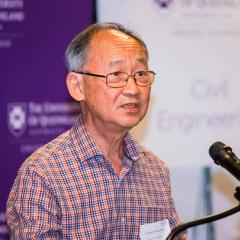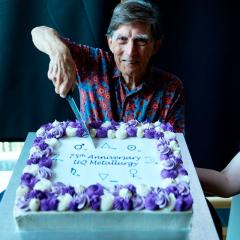Associate Professor Joe Gattas from UQ’s School of Civil Engineering has received the Excellence in Structural Engineering Education Award from the Institution of Structural Engineers (IStructE) - a prestigious international honour that celebrates excellence in teaching and student engagement in the field.
The award acknowledges Dr Gattas’ pioneering use of Augmented Reality (AR) to transform how students engage with complex structural engineering concepts, particularly in steel design.

“I was blown away to receive this recognition,” said Dr Gattas. “To have our teaching innovations acknowledged on a global stage is an incredibly rewarding - not just for me, but for the whole team involved in this work”
At the heart of Dr Gattas’ teaching is a commitment to hands-on, student-centred learning that prepares graduates for the evolving demands of modern engineering practice. His team’s interactive Augmented Reality tool is a key outcome which brings structural steel connections to life in the classroom.
“We wanted to create an experience where students actively engage with structural design, not just learn about it,” Dr Gattas explained.
“This AR tool empowers students to explore life-sized steel connections, visualise structural behaviour, and receive real-time design feedback. It’s part of our broader push to make engineering education more immersive, practical, and digitally connected.”
Developed in collaboration with PhD researcher Yuyu Wang and Associate Professor Johnny Ho, the AR teaching tool allows students to interact with full-scale 3D models of steel connections using mobile devices or AR headsets. Students can examine load paths, inspect failure modes, and customise connection components - all within a mixed-reality environment that blends digital and physical learning.
Feedback from students has been overwhelmingly positive, with many reporting improved spatial understanding and a better grasp of structural behaviour. Some even recommended introducing the tool earlier in the curriculum due to its effectiveness in clarifying abstract concepts.
Beyond the undergraduate classroom, the AR tool is part of a broader digital learning platform which enables advanced students to improve student digital literacy and develop computational design tools to support efficient structural design.
Professor Tom Baldock, Head of the UQ School of Civil Engineering, praised the achievement as a major milestone for the School and for structural engineering education more broadly.
“At UQ, we're committed to equipping and inspiring the next generation of engineers with the knowledge and skills they’ll need for the future,” Professor Baldock said.
“Joe is an exceptional educator whose passion and creativity are enriching the way structural engineering is taught. The augmented reality tool is a great example of this approach - an innovative, hands-on way to bring complex concepts to life and make them more accessible and engaging. I congratulate Joe and the whole team for this recognition.”
Dr Gattas now joins a select group of international educators recognised by IStructE for shaping the future of the profession through teaching excellence. The award includes a £1,000 prize and an opportunity to publish his work in The Structural Engineer, further showcasing UQ’s global impact in civil and structural engineering education.
The Excellence in Structural Engineering Education Award not only celebrates this innovation but reflects a forward-thinking approach to engineering education - one that positions UQ students at the forefront of an increasingly digitally driven industry.



